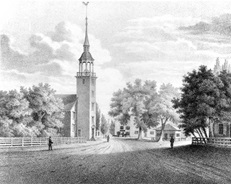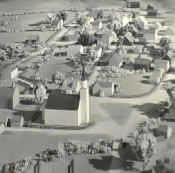Brief History of Cambridge, Mass.

The natural landscape of Massachusetts Bay was shaped by glacial action and the gradually rising sea. Human occupation in Cambridge dates back some eleven to thirteen thousand years to the melting of the last continental ice sheets. The first Europeans to document the area encountered a landscape of steep hills and islands, vast salt marshes, and shallow tidal streams meandering deep into the hinterland. This well-watered region supported a seasonal population of Algonquians who harvested shellfish and game, cultivated crops, and established footpaths connecting river crossings, settlements, and hunting grounds.
In 1630, a fleet of 11 ships carrying 700 passengers, set sail from England, bound for the Massachusetts Bay Colony. This dedicated band of Puritans hoped to build their community around a purer, more Biblical church. The newcomers settled several villages around Massachusetts Bay, but could not agree on a capital. Seeking a protected site, John Winthrop and his assistants chose a small hill on the north bank of the Charles River, at the entrance to a small creek, 5 miles upstream from Boston. The Charles was deep enough to accommodate the era's large ships, yet the passage was treacherous for those unfamiliar with the narrow channel. Later, a "pallysadoe," a series of stockade fences and a trench, was built around the town.
European-introduced diseases and tribal wars had severely impacted and reduced the size of native population prior to 1630. The English colonists secured a deed from the female chief of the Massachusett tribe, who was living near the confluence of Alewife Brook and the Mystic River. In 1640 the General Court ordered that she be paid about £23 for the land occupied by Cambridge and Watertown and given a coat every winter during her lifetime.
Newtowne, as Cambridge was called by the colonists until 1638, was laid out in an orderly grid of streets, bounded today by Eliot Square and Linden Street, Massachusetts Avenue and the River. Each family owned a house lot in the village, planting fields outside, and a share in the common land. Boston was eight long miles away: a ferry at the foot of JFK Street carried passengers over the river to a path -- now North Harvard Street -- that led through Brookline and Roxbury, eventually traversing the spit of land that is now Washington Street. Until the Great Bridge was built in 1660-62, this was the only way to Boston, except via the ferry from Charlestown.
Soon, Newtowne had a meetinghouse, a school, and a marketplace (site of today's Winthrop Square). Harvard College, one of the first colleges in America, was founded in 1636 to train young men for the ministry and positions of leadership within the godly community.

Model of Cambridge in 1776
By the time of the American Revolution, Cambridge was a quiet New England farming village clustered near the Common and the College. The majority of residents were descendants of the original Puritans -- farmers, artisans, and tradesmen, whose lives focused on Cambridge. Distinctly different were a small group of Anglicans -- barely a dozen households -- who lived apart from village affairs, relied on outside incomes, and entertained lavishly in grand homes along Tory Row (now Brattle Street). The Tories' houses and their church, Christ Church, still survive.
William Dawes rode out Massachusetts Avenue on his way to Concord on April 18, 1775. The following afternoon, four Cambridge Patriots died in a skirmish with retreating British regulars at the corner of Massachusetts and Rindge Avenues. The provisional government confiscated many Loyalist estates -- George Washington used the Vassal-Craigie-Longfellow House as his headquarters for nine months in 1775-6. During the Siege of Boston, the General supervised the construction of three earthenwork forts along the Cambridge side of the Charles River. The remains of one, Fort Washington, can still be seen in Cambridgeport.
Cambridge became a city in 1846, uniting three rival villages -- Old Cambridge, Cambridgeport and East Cambridge.
Old Cambridge had grown slowly and still retained its charming rural character. Small shops catered to the community and to students. Drawn by Harvard, and later Radcliffe College, brilliant men and women imparted an intellectual luster to the village. Henry Wadsworth Longfellow, James Russell Lowell, Elizabeth Cabot Cary Agassiz (founder of Radcliffe), William Dean Howells -- all were seen on the streets of the village.
Before the opening of the West Boston (now Longfellow) Bridge in 1793, only three families lived east of Quincy Street. The bridge offered the first direct route from Cambridge to Boston and cut the distance between the two from 8 to 3 miles. Cambridgeport grew up along the roads leading to the bridge. Pleasant residential neighborhoods spread out from Massachusetts Avenue, while Central Square became the city's true downtown. Margaret Fuller, writer and editor -- and the first woman allowed to use the Harvard library -- grew up in Cambridgeport, as did Richard Henry Dana, author of Two Years Before the Mast. Abolitionist William Lloyd Garrison was a resident.
East Cambridge was opened for development in 1809, when the Canal Bridge, adjacent to the present Museum of Science, was completed. The area was the city's major industrial center until the 1880s. Furniture and glass factories were among the industries attracted to East Cambridge by cheap land, water transportation, and close proximity to Boston. Andrew Craigie, a leading Cambridge speculator, lured the Middlesex County courthouse and jail to East Cambridge by offering to donate new buildings in 1813. In 1841, social activist Dorothea Dix was outraged by conditions in the jail and began her pioneering work in prison reform.
The devastating potato blight that struck Ireland in 1845 caused many of that country's rural population to flee. Thousands landed in Boston and Cambridge, destitute and without resources. Many Irish immigrants worked in the clay pits and brickyards of North Cambridge, housed in crowded workers' cottages. The majority of the city's Irish lived in East Cambridge, laboring at unskilled jobs in the glass works and furniture factories. They developed a close-knit community, centered on and supported by the Catholic church. By 1855, twenty-two percent of the adults in East Cambridge were Irish-born.
Around the turn of the twentieth century, immigrants from Italy, Poland, and Portugal began to arrive in the city, settling primarily in Cambridgeport and East Cambridge. French Canadians and Russian Jews came at this time, as well, settling in North Cambridge and Cambridgeport, respectively.
A small population of African Americans had lived in Cambridge from the earliest Colonial days, and in the early nineteenth century Cambridge's integrated schools attracted many families from Boston. Harriet Jacobs, born a slave in North Carolina, ran a boarding house in Cambridge in the 1870s. She had lived in hiding for 7 years before escaping to the North and later wrote an account of her years in bondage, Incidents in the Life of a Slave Girl. Educator Maria Baldwin, a lifelong Cambridge resident, held home study classes for Harvard's Black students, including W.E.B. DuBois. In 1889, she was appointed headmaster of the Agassiz School, the first African American to hold such a position in the North. Twenty markers commemorating prominent Cambridge African Americans have been erected throughout the city.
Today, Cambridge is home to a culturally diverse population of over 100,000. College students from around the world study at Harvard University, the Massachusetts Institute of Technology and Lesley University. The heavy industries of the nineteenth and early twentieth centuries have been replaced by technology-based enterprises, including software and biotechnology research.
--Cambridge Historical Commission
Further Reading: